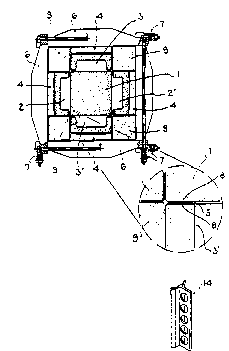Some of the information on this Web page has been provided by external sources. The Government of Canada is not responsible for the accuracy, reliability or currency of the information supplied by external sources. Users wishing to rely upon this information should consult directly with the source of the information. Content provided by external sources is not subject to official languages, privacy and accessibility requirements.
Any discrepancies in the text and image of the Claims and Abstract are due to differing posting times. Text of the Claims and Abstract are posted:
| (12) Patent Application: | (11) CA 2188805 |
|---|---|
| (54) English Title: | GAS SUPPLY ARRANGEMENT FOR HIGH-TEMPERATURE COMPONENTS |
| (54) French Title: | DISPOSITIF D'ALIMENTATION EN GAS POUR COMPOSANTS A HAUTE TEMPERATURE |
| Status: | Deemed Abandoned and Beyond the Period of Reinstatement - Pending Response to Notice of Disregarded Communication |
| (51) International Patent Classification (IPC): |
|
|---|---|
| (72) Inventors : |
|
| (73) Owners : |
|
| (71) Applicants : |
|
| (74) Agent: | SMART & BIGGAR LP |
| (74) Associate agent: | |
| (45) Issued: | |
| (86) PCT Filing Date: | 1996-02-22 |
| (87) Open to Public Inspection: | 1996-09-06 |
| Availability of licence: | N/A |
| Dedicated to the Public: | N/A |
| (25) Language of filing: | English |
| Patent Cooperation Treaty (PCT): | Yes |
|---|---|
| (86) PCT Filing Number: | PCT/EP1996/000727 |
| (87) International Publication Number: | WO 1996027113 |
| (85) National Entry: | 1996-10-24 |
| (30) Application Priority Data: | ||||||
|---|---|---|---|---|---|---|
|
The invention concerns a high-temperature component (1) made from
ceramic material with channels through which gases can flow and with
connection elements (2, 2', 3, 3') provided to allow the supply and discharge
of gases; the connection elements (2, 2', 3, 3') are forced onto the surfaces
of the high-temperature components (1) by mechanical contact pressure. It
is proposed that the contact pressure should be applied by means which
are substantially not adversely affected by high temperatures in the high-
temperature component (1).
L'invention concerne un composant à haute température (1) constitué d'un matériau céramique et pourvu de canaux à travers lesquel s peuvent s'écouler des gaz ainsi que d'éléments de raccordement (2, 2', 3, 3') servant à l'amenée ou à l'évacuation des gaz. Les éléments de raccordement (2, 2', 3, 3') sont montés en force et maintenus sur la surface des composants à haute température (1) par application d'une pression agissant mécaniquement. Il est proposé, selon l'invention, que cette pression soit appliquée par des moyens qui ne sont sensiblement pas affectés de façon préjudiciable par les températures élevées régnant dans le composant à haute température (1).
Note: Claims are shown in the official language in which they were submitted.
Note: Descriptions are shown in the official language in which they were submitted.

2024-08-01:As part of the Next Generation Patents (NGP) transition, the Canadian Patents Database (CPD) now contains a more detailed Event History, which replicates the Event Log of our new back-office solution.
Please note that "Inactive:" events refers to events no longer in use in our new back-office solution.
For a clearer understanding of the status of the application/patent presented on this page, the site Disclaimer , as well as the definitions for Patent , Event History , Maintenance Fee and Payment History should be consulted.
| Description | Date |
|---|---|
| Application Not Reinstated by Deadline | 1999-02-22 |
| Time Limit for Reversal Expired | 1999-02-22 |
| Inactive: Status info is complete as of Log entry date | 1998-09-18 |
| Inactive: Delete abandonment | 1998-09-14 |
| Inactive: Abandoned - No reply to Office letter | 1998-06-11 |
| Inactive: Abandoned - No reply to Office letter | 1998-06-11 |
| Deemed Abandoned - Failure to Respond to Maintenance Fee Notice | 1998-02-23 |
| Application Published (Open to Public Inspection) | 1996-09-06 |
| Abandonment Date | Reason | Reinstatement Date |
|---|---|---|
| 1998-02-23 |
Note: Records showing the ownership history in alphabetical order.
| Current Owners on Record |
|---|
| DORNIER GMBH |
| LICENTIA PATENT-VERWALTUNGS-GMBH |
| Past Owners on Record |
|---|
| KARL KRIECHBAUM |
| RICHARD SPAH |